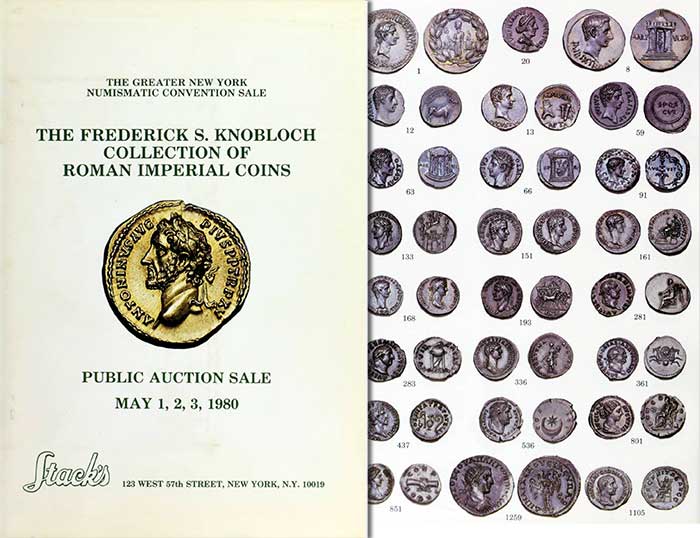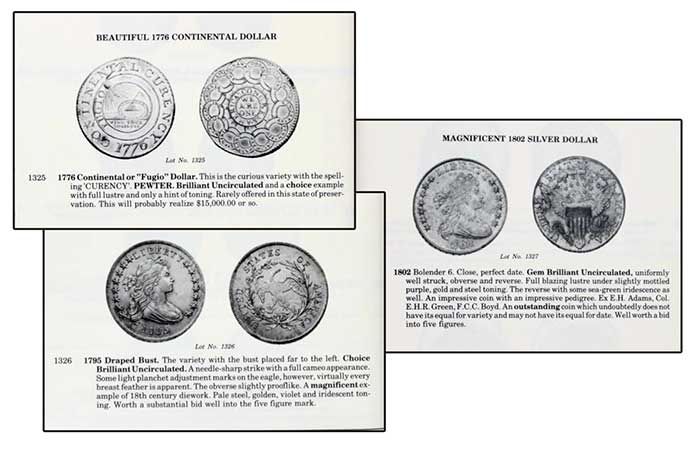
By Harvey Stack – Co-Founder, Stack’s Bowers Galleries ……
Changes in the Numismatic World
The year 1980 began with a crash in the silver market.
For years before, the price of silver had risen slowly, inducing people to start selling any and all silver items they had laying around the house. But in a short period of time (starting during the last quarter of 1979), the silver market dropped dramatically. Within months, the price of silver plummeted to $10 an ounce from a high of $50 per ounce – and it threatened to go lower.
As explained in earlier installments of “Growing up in a Numismatic Family”, the whole silver boom started about 1978 when the famous Nelson Bunker Hunt and the Hunt Brothers tried to corner the market in the precious metal.
They bought tons of silver with each trade, spending millions of dollars getting positions and influencing others to do the same. The Hunt Brothers speculated that the market would carry the price up from the low teens to $100 an ounce or more. They pledged the millions of ounces they had, bought more on margin, and created by the later part of 1979 a real “bull market” in silver bullion ownership. And it wasn’t solely here in the United States, but with the constant increase in value, banks and traders worldwide followed their lead and bought and speculated in futures on this market.
When some of their loans came due, the Hunts were initially covered but were soon unable to muster the necessary cash. Markets began to panic sell and flooded the market with the actual silver from banks and vaults, and created a down market the likes of which had never been seen before. The constant calls for CASH to cover brought the entire Hunt Family to bankruptcy, as well as the many people who bought high (up to $50 per ounce, much on margin) but were forced to sell low. And sell they did, with many losing over 70-80% of their initial investment.
 Did that deter the Hunts? Did they learn anything? The Hunts were so sure that the market would return to highs that they began to help propagate the rumor that the United States Mint and the Treasury Department would start buying again and re-stimulate interest.
Did that deter the Hunts? Did they learn anything? The Hunts were so sure that the market would return to highs that they began to help propagate the rumor that the United States Mint and the Treasury Department would start buying again and re-stimulate interest.
They were SO WRONG!
The initial collapse of SILVER, considered an important monetary item that backed the paper currency and bonds the United States issued, caused a drop in all markets. It affected everything, from farm produce to the value of gold, and industries that needed and were therefore forced to buy silver at high prices, often on contracts, were “stuck” with a devalued asset. Havoc spread everywhere.
Coin buyers, who used some of the profits they had made trading silver in previous years, had little left to continue buying numismatic items at premium prices. So many of them either stopped collecting, sold their collections, or just stored away what they had while they waited to see if the market went back up.
Oddly enough, with silver dropping in 1980, and the Mint having on hand many tons of the metal for making silver coins, Proof sets continued to be produced. The cost of such Proof sets initially remained the same, but the Mint profited from the lower cost of silver if they had to replace their stock.
But with the monetary system in an uproar, there was a lack of interest on the part of the collecting public to maintain and add to their collections.
During the eighties, the Mint had a large number of silver coins and Proof sets in their vaults, unable to sell what they struck or provide it for circulation. A perfect example is the huge quantity of silver dollars still in treasury vaults. There were so many silver dollars, struck between 1873 and 1878 and never circulated, that new ones were no longer struck (except Trade Dollars, which we used for oversea trade and payments). The silver market episode of the late ’70s and early ’80s had major consequences for the economy over the next decade or so, affecting all aspects.
Stack’s soldiered on during this period. In the 1980s, we continued to buy and sell coins (at lower prices than earlier), and because we maintained a large, diversified inventory of Ancient and Modern US and World coins, we were able to serve those collectors who still had enough capital to buy. We were also, though on a smaller scale than in the previous decade, able to sell some important collections at public auction. Running a coin business during these “hard monetary times” wasn’t easy, but Stack’s maintained a clientele who were still able to continue their numismatic interests.
Auctions 1980
FEBRUARY: A consignment from several important places, highlighted by a comprehensive collection from the New Canaan Historical Museum, together with a collection of Charlotte Mint gold assemble by one Parks Dalton who, with his father and brother, assembled a major offering of this very popular Southern mint series. In addition, there were several other choice collections of coins in top grades for the general collector to acquire. The February sale had a total of 1,028 lots.

May: THE FREDERIC S. KNOBLOCH COLLECTION OF ROMAN IMPERIAL COINS Sold in conjunction with the Metropolitan New York Numismatic Convention held at the Park Sheraton hotel in New York. 1,438 Lots. This was one of the most extensive collections of Roman Imperial coins offered for sale in the 20th Century.
Fred Knobloch was a dedicated collector of coins of the ancient world. During the decade that preceded this sale, Fred consigned collections of Ancient Greek coins, and later his collection of Roman Ancients. Both collections had a huge assortment of gold, silver and bronze specimens. Because Fred was of modest means, having worked for a major government agency, the funds he had to build a superior collection were limited. He, therefore, sold his Greek and Roman Republic coins in order to concentrate on the Roman Imperial series.
Incidentally, Fred was also an active member of all nine numismatic clubs in the Metropolitan New York area, where he displayed and lectured on various aspects of collecting Ancients. In New York, he had available to him the coins of the American Numismatic Society, the Brooklyn Museum, the Metropolitan Museum of Art and the Morgan Library, which always invited him for displays and lectures.
Fred worked with our catalog team, arranging and describing each coin in the series. The catalogs of the Knobloch sales became guides for other collectors to pursue Ancient coins, and are still used to this day. I was fortunate to work with Fred almost every weekend.
The Convention and his auction attracted dealers and collectors from all over the world, and each of the sales brought wonderful prices because of the Knobloch pedigree. Even with the silver market nadir and its negative effect on numismatics in general, the ability to bid on the Knobloch specimens set was a shining numismatic moment during this economically demoralizing period. Some prices achieved were records for the time.
JUNE: A 1,081-lot offering of several important collections of U.S., Foreign, and Ancient gold, silver and copper coins, having 920 U.S. and 160 World coins assembled from various consignors. It was a popular sale, for it contained a variety of both general coins and rarities to serve the overall collector. The success of this sale was evidence to us that there still was an enthusiastic market for numismatic items, even though there was a drop in value for the United States coins on offer. The market in U.S. coins started to return to its higher values later in the summer.

AUGUST: Stack’s once again joined the Apostrophe partnership to auction a special group of rare numismatic coins, wherein each company offered 500 lots in the joint sale called AUCTION ‘ 80, which was a successful event started in 1979. The Stack’s section had rare type, early Liberty Seated and Barber Proof Sets, and series of minor coins in both Proof and Mint State. We also offered an extensive selection of early Morgan silver dollars. The partners offered complimentary coins to enhance the sale.
Again, this summer sale, held in Cincinnati, still attracted collectors from all over the country and the bidding was very enthusiastic.
SEPTEMBER: After the very successful sale of the Knobloch collection, we received a number of choice and rare specimens of Ancient and Foreign gold and silver coins. Though the sale was small (only 524 lots), a number of popular rarities attracted a large number of mail-bid sheets and phone bids, as well as a large audience of advanced collectors. Activity at this sale seemed to confirm that interest in collecting was reviving.
OCTOBER: Stack’s was consigned the Estate of Charles Kahn, a 985-lot collection of United States gold, silver, and copper coins, mostly in choice and better grade. It was assembled over several decades and because of the extent of the offering, once again, a crowd of well-known and outstanding collectors came to New York to participate in the sale. Though the market was not as high as a few years back, the overall scope and quality of the collection created near or actual high prices.
DECEMBER: Several comprehensive collections of popular denominations of U.S. gold, silver and copper were offered together in 858 lots that we weren’t able to fit into our November sale. It attracted many buyers via mail bid and/or personal attendance, and the timing was almost at the Christmas holidays, so collectors who came to the auction could send their wives shopping while they attended and bid on the sale. Sometimes, timing can make a sale successful!
The year 1980 was not an easy one to navigate through, but with the number of consignments we were able to obtain and sell, and with our active clientele who were still able to buy from us, we made it through the year somewhat successfully.
* * *
Links to Earlier Parts:
1928-35 | 1935-45 | 1945-51 | 1951-52 | 1954 | 1955-56 | 1957 | 1958-59 | 1960 | 1961-62 | 1963 | 1964 | 1965 | 1966 | 1967 | 1968-69 | 1970-71 | 1972 | 1973 | 1974 | 1975 | 1976 | 1977 | 1978 | 1979





I remember typing a lot of cards up for my grandfather to catalogue his coins. Frederick Knobloch knew his coins. Was an authortive man in his field